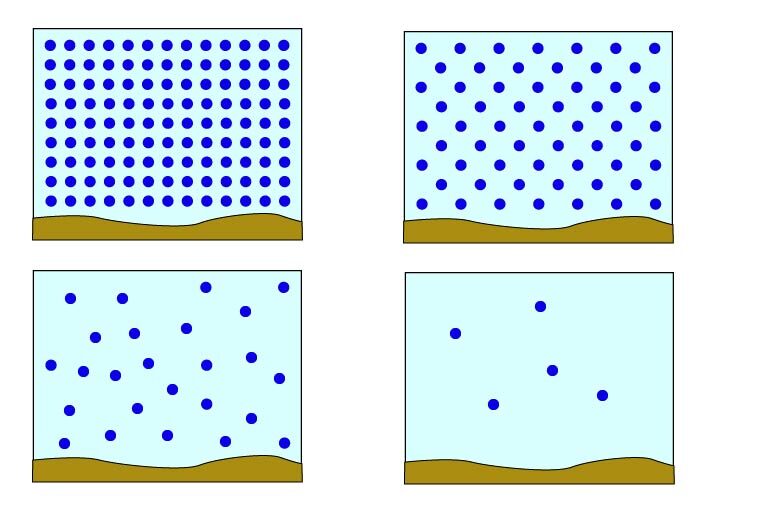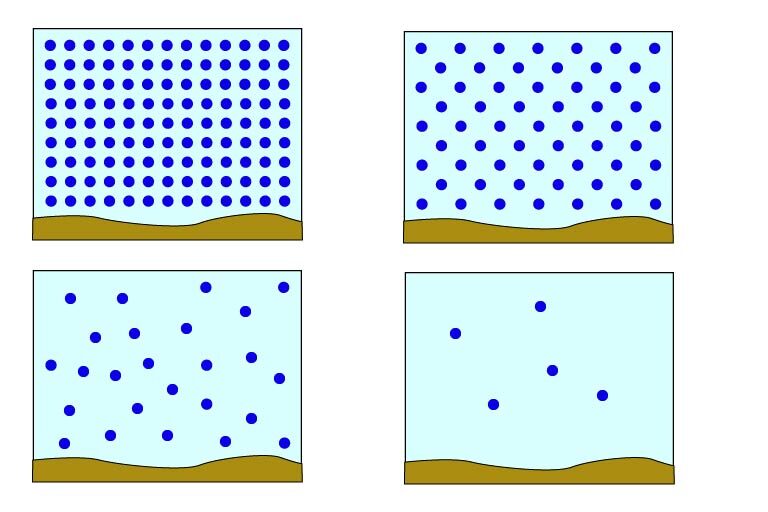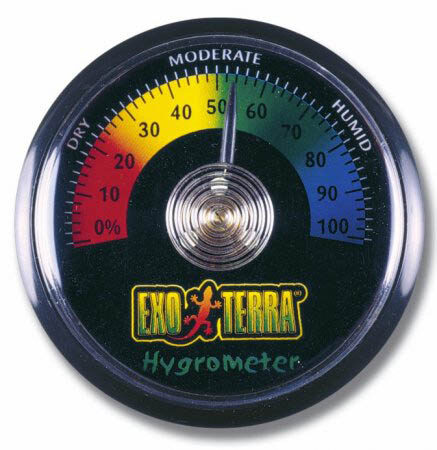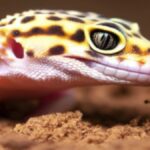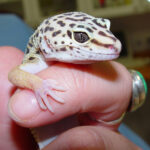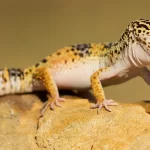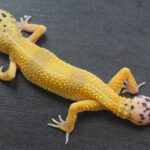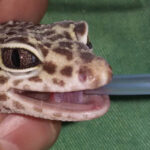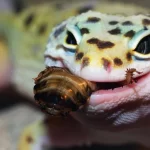Although often neglected, the humidity of Leopard geckos is an important environmental factor that needs to be considered and managed.
Introduction to Leopard gecko humidity
Humidity refers to the amount of water vapour in the air. The humidity can be measured as absolute humidity or relative humidity.
The humidity of pet Leopard geckos is often not considered or neglected. Although Leopard geckos are naturally distributed in the dry, semi-arid South Asian deserts, they do prefer microhabitats that are a little more humid(49).
There are two main areas where Leopard geckos are exposed to humidity. They are the environmental humidity and hide box humidity.
Absolute humidity and relative humidity
Humidity is defined as the concentration of water, in the form of vapour, in the air. Water vapour is the gaseous state of water and is invisible to the human eye. Humidity, also known as the absolute humidity, is measured as grams of water in a letter of air (mass/volume).
Humidity can also be expressed as the relative humidity which is the amount of vapour in the air as a percentage of the space of air that can hold vapour. Higher percentages mean more water and lower percentage means less water in the air. Relative humidity (also expressed as %RH) can be measured using a hygrometer.
A visual representation of humidity. The area above the brown represents the volume of air in which water can evaporate and the blue particles represent the evaporated water particles. The highest RH is on the top left and the lowest on the bottom right.
In the case of Leopard geckos, the areas that can hold vapour are the enclosure itself and smaller containers such as hide boxes and humidifying shelters.
For Leopard geckos, the humidity is dependant on the temperature, the volume/size of the enclosure, the amount of water in the enclosure and the amount of ventilation. It is also dependant on the area of the enclosure they find themselves in, e.g. inside or outside the humidifying shelter. Water is introduced in the form of drinking water, misting and moist substrates. The most significant way to increase the humidity for pet Leopard geckos is by adding a humidifying shelter.
In nature, there will be a slight increase in the humidity of the immediate area where there are rocks, vegetation and water sources. These are the areas Leopard geckos prefers to spend most of their time(49).
For Leopard geckos, there are two main areas where they are exposed to humidity: environmental humidity and hide box humidity.
Environmental humidity of Leopard geckos
The environmental humidity of Leopard geckos is the humidity inside the main enclosure. When compared with hiding boxes, the volume of the main enclosure is much bigger and, therefore, has lower humidity.
Hide box humidity of Leopard geckos
Hide boxes, also referred to as humidifying shelters and moist hides, are boxes placed on the inside of the main enclosure. Apart from supplying areas to hide in, one of their main purposes is to supply area where the humidity is high. By having a moist substrate, a smaller volume and less ventilation, the humidity inside hide boxes are much higher than that of the environment.
Also see
Leopard gecko hide areas and hide boxes
Why humidity is important for Leopard geckos
Leopard geckos need areas with low humidity and areas with higher humidity. Generally, the required humidity for Leopard geckos is relatively low but there are times when higher humidities are needed(34)(50). Overall too high humidity will lead to an increase in diseases such as intestinal parasites, skin and mouth infections, and pneumonia.
Humidity is believed to be one of the factors affecting the frequency of skin shedding in Leopard geckos(55). When the overall humidity is low, the risk for dehydration, overheating and skin shedding problems increase(30).
Also see
Leopard gecko skin shedding — an ‘a pealing’ affair
Factors affecting humidity of Leopard geckos
Apart from the size of the enclosure, or the area for water to evaporate in (which is usually relatively small in the case of Leopard gecko enclosures), factors such as ventilation, temperature, substrate and the amount of water available greatly affect the humidity.
Comparatively more ventilation, larger enclosures, smaller water dishes and higher temperatures lead to lower humidities. The opposite is true for less ventilation, smaller enclosures, larger water dishes and lower temperatures. Cooler air doesn’t require as much moisture to become saturated when compared with warmer air.
In the case of pet Leopard geckos, we have the most control over the temperature, the size of the water dish and the presence or absence of humidifying shelters.
Also see
Suitable substrates for Leopard geckos
Supplying heat to pet Leopard geckos
Leopard geckos are naturally found in the drier, semi-arid/desert areas of South Asia. In Pakistan, the relative humidity outside ranges from 23-40% in summer and 70-80% winter(49). Because of the cooler air, evening humidities are higher than those during the day.
During the warmer days, wild Leopard geckos will find shelter in areas where there are shade, vegetation and even sources of water — in other words, areas with higher humidities. While the outside relative humidity can drop to as low as 23-32% in summer, the humidity in their daytime resting places will remain at 40-56% — which is ideal for Leopard geckos(49).
Measuring relative humidity
The relative humidity can be measured with a hygrometer. By looking around, small commercial hygrometers might be available from some pet shops or online from websites such as Amazon.com. Some Leopard gecko keepers are also handy enough to make their own hygrometer.
Exo-Terra produces a very popular, small and cost-effective reptile hygrometer. Available from Amazon.com
A terrarium hygrometer can be placed directly in the space where you want to measure the relative humidity. The measurement is made using air. It is always a good idea to take multiple readings, for example during the day and during the evening.
Approaching humidity for Leopard geckos
The general idea is to have an enclosure with fairly low humidity and one or more humidifying shelters with higher humidities.
In order to keep the enclosure’s humidity low, a small water dish, sufficient ventilation and the correct temperature (25–30 ºC / 77–86 ºF(23)) needs to be supplied. A thermometer can be used to test the temperature.
A humidifying shelter can be as simple as a plastic container with an opening in the lid filled with a layer of moist substrate. Suitable substrates include moist (not wet), peat/sphagnum moss(34) or vermiculite(30).
When the humidity is incorrect
Apart from using a hygrometer, incorrect humidities can also be seen in the health status or behaviour of Leopard geckos. When the overall humidity is too high, Leopard geckos might become prone to diseases such as intestinal parasites, skin and mouth infections, and pneumonia.
When the overall humidity is too low, the risk for dehydration, overheating and skin shedding problems increase(30). Skin shedding problems (or dysecdysis) is most commonly seen — especially when a humidifying shelter is not supplied.
Behavioural changes include excessive climbing behaviour, spending too much time hiding away, open mouth breathing and excessive soaking behaviour.
Also see
Skin shedding problems in Leopard geckos
Glass climbing behaviour in Leopard geckos
Leopard gecko soaking — warning signs
Conclusion
Although often neglected, the humidity for Leopard geckos also needs some consideration. As in nature, these Leopard geckos need areas with both low and high humidities. Areas with high humidity are best supplied using humidifying shelters.

